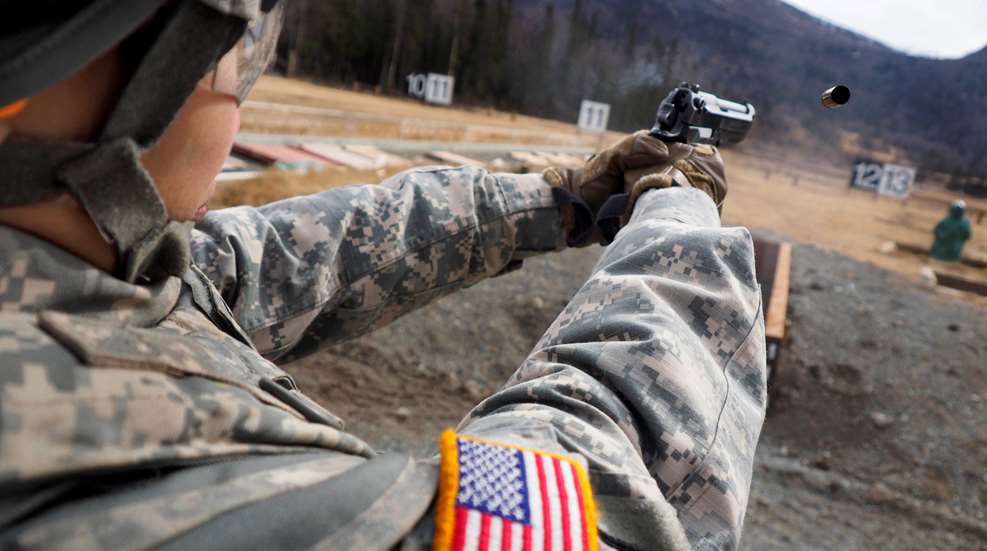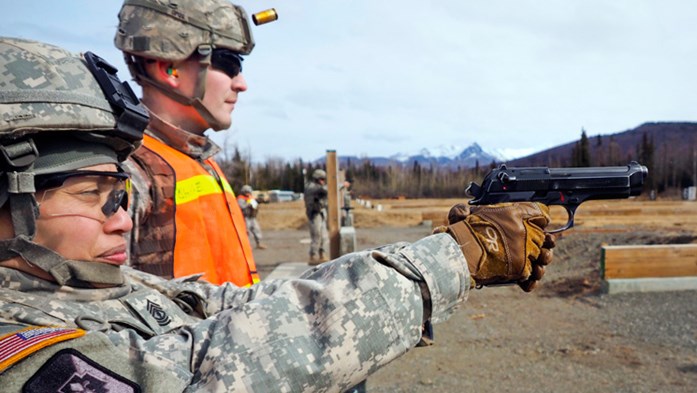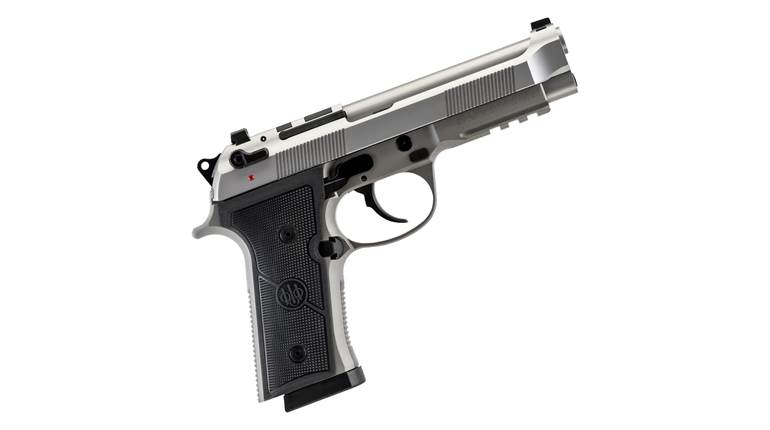
Gun fit, of course, is extremely important with shotguns. If it doesn't fit you, you miss. But what about handguns? I have stood in gun shops and at gun shows across the country and it's pretty common to hear, “This gun fits my hand.” But does it?
In order to shoot a handgun properly, one must be able to take a proper high grip. One must be able to control the gun under recoil, and that means being able to get your fingers fully around it. And you must be able to reach the controls without having to break a strong grip. One of the most disturbing range sights I've ever seen was an extremely small-handed young woman trying to hold on to a SIGP 220 in .45 ACP. It's a big, heavy gun, so the recoil was manageable, but the problem was she simply could not get a completely firm grasp on the gun. Her fingers barely stretched around the front strap.
An Army Sgt. qualifies with a Beretta M9 pistol at a combat pistol range. (Department of Defense photos)
Most people, not surprisingly, have average-sized hands. But there are extremes. One of the requirements, the many byzantine requirements, of the new Army Modular Handgun System—the deadline for which is today—is that it fit most military users’ hands. Here’s the quote from the Army’s RFP; “There is specific interest in designs that would be adaptable and/or adjustable to provide enhanced ergonomics that ensure 5th percentile female through 95th percentile male military personnel access to controls, such as the safety, magazine release, slide release and all other applicable controls.”
How the Army came up with that particular specific percentage, let alone the math required to figure out how many soldiers we are talking about here, I’m not really sure. But let’s just call them the small-handed "five percenters."
Gun manufacturers have striven to provide grip frames that fit more and more users. Part of this began with increasing numbers of women police officers, FBI agents and soldiers. And in these troubled times, more and more women who don’t wear our uniform every day are purchasing handguns as part of their personal security solutions.
There are certain design parameters that, regardless of which wonder material you use, cannot be avoided. Since Hugo Borshardt figured out the best place for a detachable magazine was inside the grip about 125 years ago, grip thickness has been a geometry problem. In handguns with a magazine loaded into the grip, there are two ways to go. One is single-stack magazine, meaning cartridges are one atop one another, and the other is double-stack. The latter meaning the cartridges are staggered in the magazine. The latter results in more rounds inside the gun, but the frame is necessarily fatter.
In cartridges used by the military and police there are certain dimensions one cannot avoid. Those include the cartridge overall length and the diameter of the cartridge itself. Again, it’s a geometry problem. For a given area of the magazine within a grip frame, you can have a certain number of 9 mm cartridges or a certain number of .40 S&W cartridges or a certain number of .45 ACP cartridges.
The interchangeable backstraps provided on the current generation of service pistols, including the Smith & Wesson M&P, H&K P2000, the Springfield XD(M) and others with such interchangeable devices, the user can adapt the guns to a lot more hand sizes. And now we have guns that have separate fire-control components separable from the grip frame itself. With the SIG P320, for example, you don't change out a backstrap, you change out the whole grip frame.
And for users of service guns, this makes a duty gun much more adaptable to potential small-handed users, as well as those with “above 95th percentile” presumably male users with ham hocks for fists on the opposite end of the spectrum.
But what about the small-handed five percenters the Army chose to leave out of its statistical spectrum? In terms of a service pistol that chambers 15 or more rounds of 9 mm Luger, they are just going to do their best to hold on.
But when it comes to personal protection guns for consumers—who get to choose their guns as opposed to having them issued—there are options. One of which is to go down in cartridge size. The .380 ACP is both shorter and smaller in diameter than the 9 mm Luger—although it delivers less ballistic performance. It’s compromise; giving up power in order to be able to run the gun. A gun built specifically around this cartridge can have a smaller magazine volume in terms of area, in particular, shorter depth. A great example of this is the Browning 1911–380. This is a gun that is an 80-percent size renditions of the classic John Browning designed M1911 pistol in .45 ACP. And it is an ideal firearm for those with terribly small hands. Too, the Springfield EMP in 9 mm is reduced in its fore and aft measurement from the M1911 due to the decreased cartridge overall length of the 9 mm cartridge over the 45 ACP. You would think a 10th of an inch would not make much difference, but it sure does if you're one of the five percenters.
Too, for the five percenters, revolvers are always an option. No one is trying to stick 17 rounds of 9 mm into the grip of a Smith & Wesson J-Frame (No, I do not think the Broomhandle Mauser is ripe for a comeback). The problem with double-action revolvers is trigger reach. Can someone with small fingers get the pad of his or her fingers to the proper position with the trigger all the way forward? I suspect this may be one of the reasons behind the new Kimber K6S revolver. Its trigger geometry does not center on a pin in the top middle of the trigger guard. If and when Kimber sends one, I have a five percenter right outside my door. I’ll let you know what she thinks.





































